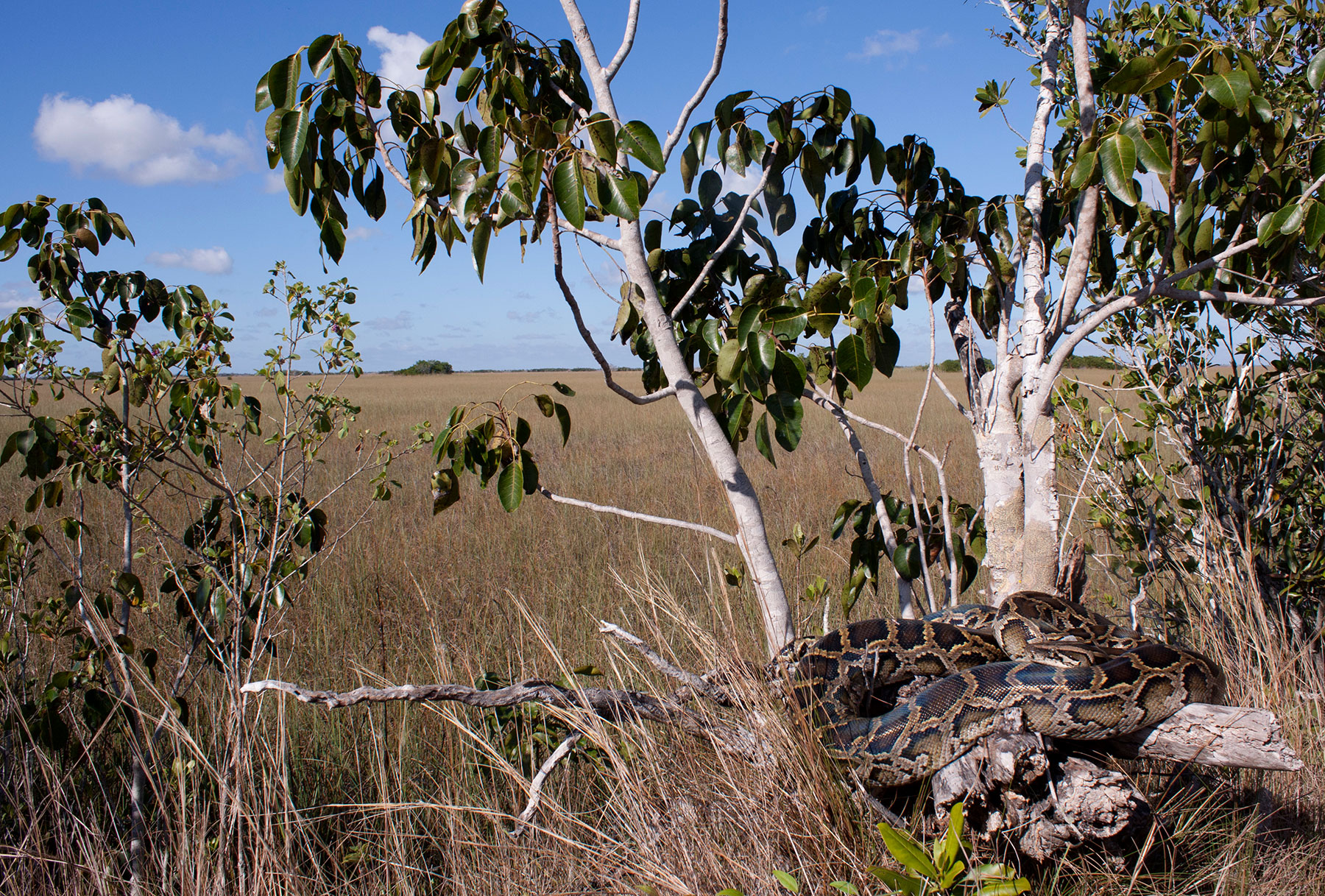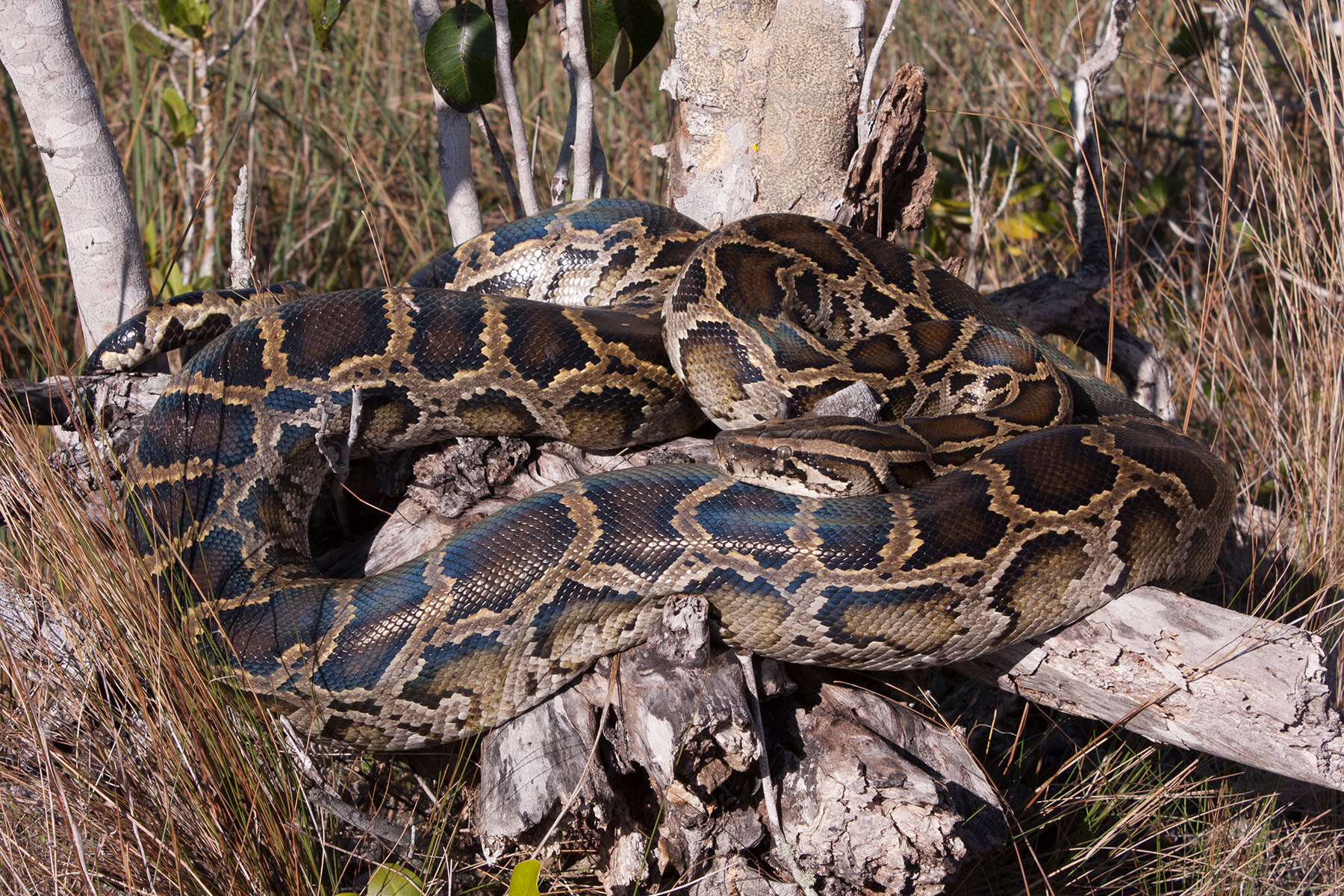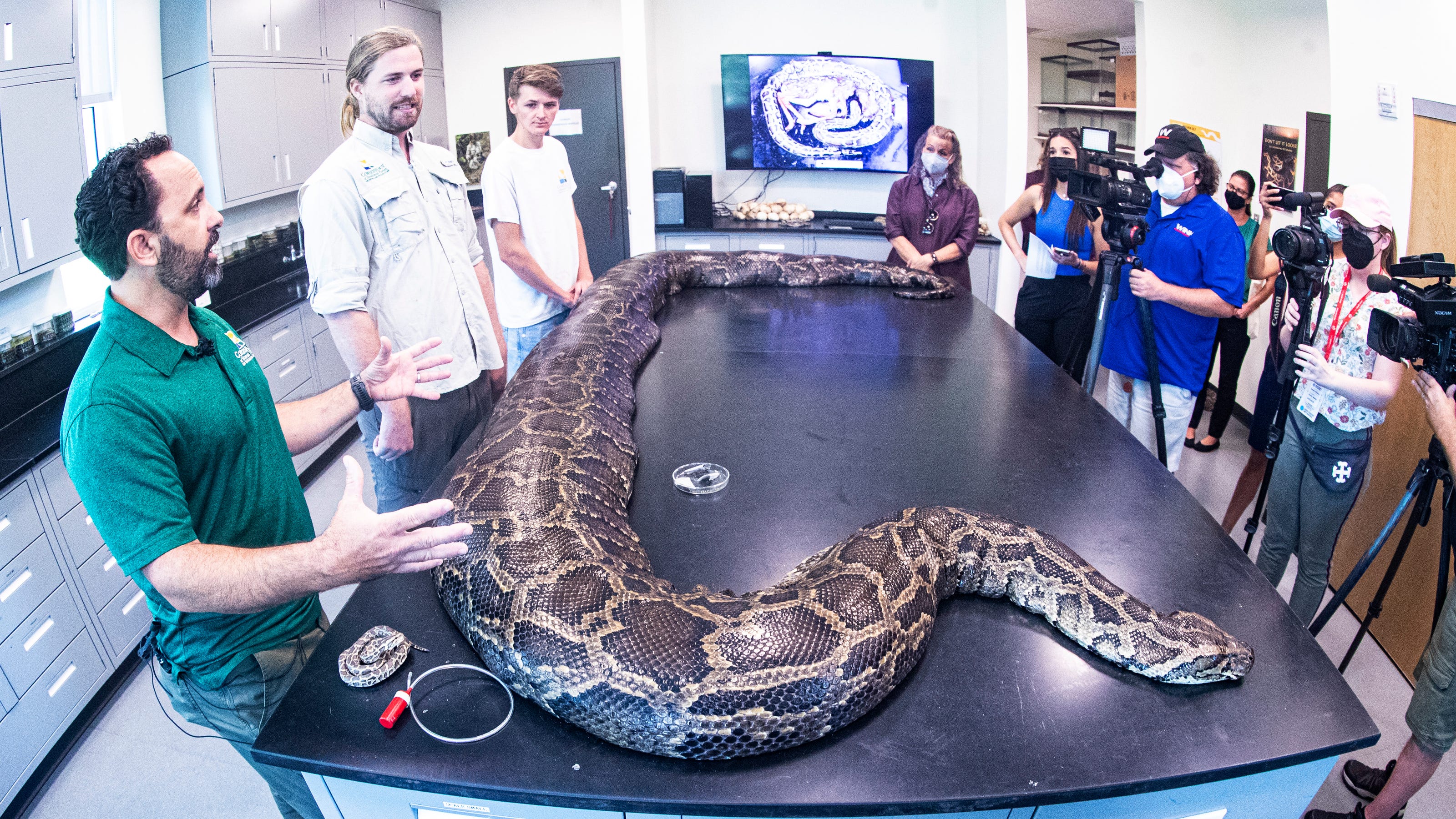Why Don't They Just Shoot The Pythons In Florida? The Untold Story Behind The Python Problem
Listen up, y’all. If you’ve been paying attention to the headlines lately, you might’ve stumbled upon some buzz about pythons in Florida. You’re probably thinking, “Why don’t they just shoot the pythons?” It’s a fair question, and trust me, it’s one that’s been asked a lot. But here’s the kicker—it’s not as simple as grabbing a rifle and heading out into the Everglades. Let’s break this down because there’s a lot more to this story than meets the eye. So, buckle up and get ready for the lowdown on why shooting pythons isn’t the quick fix everyone thinks it is.
Now, let’s talk about the elephant—or should I say, the python—in the room. The Burmese python population in Florida has exploded over the years, and it’s causing serious ecological problems. These massive snakes aren’t just chilling in the Everglades for fun; they’re devouring native wildlife, disrupting ecosystems, and turning the region into their personal playground. But here’s the thing: shooting pythons isn’t as easy as it sounds. There’s a whole lot of science, policy, and logistics that come into play, and we’re about to dive deep into all of it.
So, why don’t they just shoot the pythons in Florida? The short answer is, it’s not that simple. The long answer? Well, that’s what this article is all about. We’re going to explore the origins of the python problem, the challenges of controlling their population, and the potential solutions that are being implemented. Stick around because this is one wild ride you won’t want to miss.
- Ullu Web Series Movies Your Ultimate Guide To Indias Hottest Digital Drama
- Hdhub4ucom Hollywood Your Ultimate Guide To Streaming Hollywood Movies
Table of Contents
- The Origin of the Python Problem
- The Impact of Pythons on Florida’s Ecosystem
- Why Shooting Pythons Isn’t the Answer
- Alternative Methods for Controlling Python Populations
- Current Efforts to Combat the Python Crisis
- Challenges in Python Management
- Regulations and Policies Surrounding Python Control
- Ethical Considerations in Python Removal
- Community Involvement in Python Management
- The Future of Python Control in Florida
The Origin of the Python Problem
Let’s rewind a bit and talk about how we got here. The Burmese python isn’t native to Florida; it’s originally from Southeast Asia. So, how did these giant snakes end up in the Everglades? Well, it’s a combination of accidental releases and intentional pet dumping. Back in the day, people were buying these snakes as pets when they were small and manageable. But as they grew—sometimes up to 20 feet long!—owners realized they weren’t exactly the cuddliest companions. So, instead of dealing with them responsibly, some folks just let them loose in the wild.
Then, in 1992, Hurricane Andrew hit Florida, and a bunch of python breeding facilities were destroyed. This led to even more pythons being released into the Everglades. Fast forward a few decades, and boom—you’ve got a python population explosion. These snakes are prolific breeders, and with no natural predators in Florida, they’ve basically taken over.
Key Statistics
- Over 2,000 Burmese pythons have been removed from the Everglades since 2000.
- The python population in Florida is estimated to be in the tens of thousands.
- Pythons can lay up to 50 eggs at a time, making them incredibly difficult to control.
The Impact of Pythons on Florida’s Ecosystem
Now, let’s talk about the damage these pythons are causing. The Everglades is a delicate ecosystem, and the introduction of an invasive species like the Burmese python has thrown everything out of whack. These snakes are voracious predators, and they’re eating everything in sight—mammals, birds, reptiles, you name it. This has led to a significant decline in native wildlife populations.
For example, studies have shown that marsh rabbits, raccoons, and opossums have nearly disappeared from areas where pythons are prevalent. And it’s not just small animals that are affected; even larger species like deer and alligators are on the menu for these massive snakes. This disruption of the food chain is having ripple effects throughout the entire ecosystem, and it’s a major cause for concern.
Why Shooting Pythons Isn’t the Answer
So, why don’t they just shoot the pythons? It’s a question that gets asked a lot, and the answer isn’t as straightforward as you might think. For starters, the Everglades is a vast and rugged wilderness, and finding pythons in such a large area is no easy task. These snakes are experts at hiding, and they blend in perfectly with their surroundings. Even if you’re out there with a gun, the chances of spotting a python are slim.
Plus, there’s the issue of safety. The Everglades is home to a wide variety of wildlife, including endangered species. Shooting indiscriminately could result in collateral damage, harming other animals that are already struggling to survive. And let’s not forget about the human factor—shooting in a densely vegetated area like the Everglades poses risks to people as well.
Challenges of Shooting Pythons
- Difficult to locate pythons in the wild.
- Potential harm to other wildlife and endangered species.
- Safety concerns for humans in the area.
Alternative Methods for Controlling Python Populations
Okay, so if shooting isn’t the answer, what are the alternatives? There are actually several methods being used to control the python population in Florida, and they’re proving to be much more effective than simply shooting the snakes. One of the most successful approaches is the use of trained python hunters. These individuals are skilled at finding and capturing pythons, and they’re making a real difference in the fight against this invasive species.
Another method gaining traction is the use of technology. Scientists are experimenting with drones and thermal imaging cameras to locate pythons in the wild. These tools allow them to spot snakes that would otherwise be impossible to find. Additionally, researchers are exploring the use of pheromones to lure pythons into traps, making it easier to capture them.
Effective Python Control Methods
- Trained python hunters.
- Drone and thermal imaging technology.
- Pheromone-based traps.
Current Efforts to Combat the Python Crisis
There’s a lot of work being done to address the python problem in Florida, and it’s a collaborative effort involving government agencies, scientists, and local communities. The Florida Fish and Wildlife Conservation Commission (FWC) has launched several initiatives aimed at reducing the python population. One of the most notable is the Python Elimination Program, which pays hunters to remove pythons from the wild.
In addition to these programs, there are also public awareness campaigns designed to educate people about the dangers of releasing non-native species into the wild. The goal is to prevent future invasions by encouraging responsible pet ownership and proper disposal of unwanted animals.
Key Initiatives
- Python Elimination Program.
- Public awareness campaigns.
- Research and development of new control methods.
Challenges in Python Management
Despite these efforts, there are still plenty of challenges when it comes to managing the python population in Florida. One of the biggest hurdles is funding. These programs require a lot of resources, and securing the necessary funding can be a difficult task. Additionally, there’s the issue of public perception. Some people may not fully understand the severity of the problem, which can make it harder to gain support for these initiatives.
Another challenge is the sheer size of the Everglades. It’s a massive area, and covering every inch of it is practically impossible. This makes it difficult to completely eradicate the python population, and it’s likely that these snakes will continue to be a problem for years to come.
Regulations and Policies Surrounding Python Control
There are several regulations and policies in place to address the python problem in Florida. The state has banned the importation and possession of Burmese pythons, and it’s illegal to release them into the wild. These laws are designed to prevent further introductions of the species and to encourage responsible pet ownership.
In addition to these regulations, there are also guidelines for python hunters. They must be properly trained and licensed, and they’re required to follow strict protocols when capturing and handling these snakes. These measures are in place to ensure the safety of both the hunters and the environment.
Ethical Considerations in Python Removal
Let’s not forget about the ethical side of things. While it’s important to control the python population, it’s also crucial to do so in a humane way. This means using methods that minimize suffering and avoid unnecessary harm. Python hunters are trained to euthanize the snakes quickly and painlessly, ensuring that they don’t endure any unnecessary distress.
There’s also the question of whether it’s right to blame the pythons for being in Florida in the first place. After all, they didn’t choose to be here—they were brought here by humans. This raises some interesting ethical questions about our responsibility to address the problems we’ve created.
Community Involvement in Python Management
Community involvement is a key component of python management in Florida. Local residents are encouraged to report python sightings and participate in removal efforts. This not only helps to control the population but also raises awareness about the issue and fosters a sense of shared responsibility.
There are also volunteer programs that allow people to get hands-on experience with python removal. These programs provide training and resources to help participants safely and effectively capture pythons. By involving the community in these efforts, we’re creating a network of support that’s crucial for addressing this complex problem.
The Future of Python Control in Florida
So, where do we go from here? The python problem in Florida isn’t going to disappear overnight, but with continued efforts and innovation, we can make significant progress. The key is to stay vigilant, adapt to new challenges, and remain committed to finding solutions that work for both the environment and the community.
As technology advances, we may see new and more effective methods for controlling the python population. And with increased public awareness and participation, we can create a sustainable approach to managing this invasive species. The future may be uncertain, but one thing is clear: we can’t give up the fight.
Conclusion
Alright, folks, that’s the scoop on why they don’t just shoot the pythons in Florida. As you can see, it’s a complex issue with no easy answers. But through collaboration, innovation, and dedication, we can make a difference in the battle against this invasive species.
So, what can you do to help? Start by educating yourself and others about the python problem. If you live in Florida, consider getting involved in python removal efforts or reporting sightings to the authorities. And most importantly, never release non-native species into the wild—it’s not just bad for the environment; it’s illegal.
Now, it’s your turn. Drop a comment below and let me know your thoughts on this issue. Are there any solutions you think we should explore? Or maybe you have a question about something we covered. Whatever it is, I’d love to hear from you. And don’t forget to share this article with your friends and family—spreading the word is one of the best ways to make a difference. Thanks for reading, and let’s keep the conversation going!
- Skymovieshdin 2025 Your Ultimate Guide To Streaming Movies Like A Pro
- 5 Mustwatch Kannada Movies That Will Blow Your Mind

Burmese Python Florida Snake ID Guide

Burmese Python Florida Snake ID Guide

Recordbreaking 18foot Burmese python caught in Florida Everglades